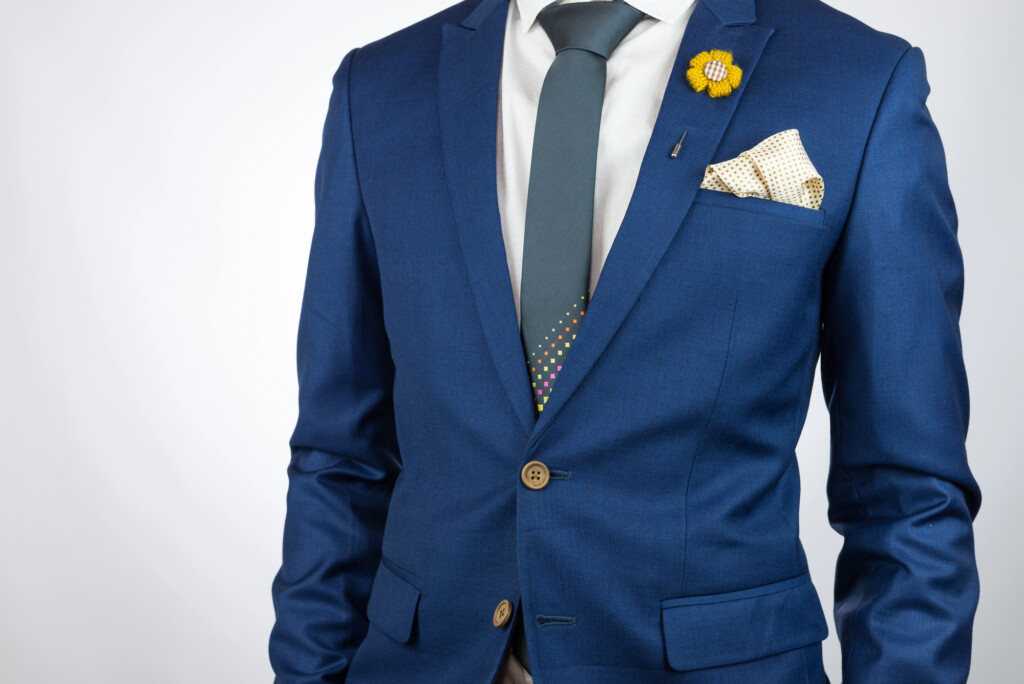In the lexicon of men’s style, few debates spark as much quiet fervor as the choice between lapel pins and boutonnieres. Both serve as subtle exclamation points on a well-tailored suit, yet their origins, symbolism, and practicality couldn’t be more distinct. Whether you’re dressing for a black-tie gala, a summer wedding, or a high-stakes corporate event, the question lingers: Which of these lapel adornments truly elevates your look without tipping into excess? Let’s dissect the nuances, decode the history, and deliver a verdict tailored to your next occasion.
The Heritage Factor: A Tale of Two Traditions
Boutonnieres trace their lineage to the 16th century when European knights tucked fragrant herbs into their lapels to ward off evil spirits (and body odor). By the Victorian era, they’d evolved into romantic gestures, single blooms like roses or carnations symbolizing everything from love to secrecy. Fast-forward to 2024, and the fresh floral boutonniere remains a staple of weddings and proms, evoking nostalgia and organic elegance.
Lapel pins, meanwhile, began as military insignias and civic badges. The Masonic square and compass or Rotary International emblems signaled allegiance long before they became fashion statements. Today, they’re reimagined as minimalist metal designs, enamel crests, or even whimsical motifs (think: a tiny astronaut or vintage car). Unlike their botanical counterparts, lapel accessories carry a modernist edge—durable, reusable, and ripe for personalization.
The Practicality Playbook: Durability, Cost, and Versatility
1. Durability: A Battle of Ephemeral vs. Eternal
- Boutonnieres: A fresh flower lasts 8–12 hours. By midnight, that gardenia will wilt—a poetic metaphor for life’s impermanence, perhaps, but a logistical headache if you’re juggling a multi-day event.
- Lapel Pins: Forged from brass, enamel, or sterling silver, these timeless suit adornments survive rain, heat, and decades. Pin a vintage Art Deco design to your tuxedo, and it’ll outlive the suit itself.
2. Cost Analysis: Single-Use Splurge vs. Investment Piece

Let’s talk numbers—because even style has a budget.
- Floral Boutonniere: Between $15 to $50, depending on how exotic your bloom of choice is. Now, multiply that by a wedding party of ten, and suddenly you’re staring down a four-digit expense for something that’ll wilt before the last dance. It’s a romantic gesture, sure, but one that ends in a compost bin by sunrise.
- Custom Lapel Pin: From $10 to $100 per piece, but unlike its ephemeral counterpart, this accessory isn’t going anywhere. That $50 enamel pin? Wear it to 50 events, and you’re down to a dollar per wear—a cost-efficiency play so sharp, it’d make even the savviest investor nod in approval. Think of it as a sartorial heirloom: timeless, reusable, and immune to the ravages of time (or open-bar mishaps). No floral funeral, no repeat spending. Just cold, hard math dressed in a tuxedo.
3. Versatility: From Boardroom to Ballroom
- Boutonnieres scream “special occasion.” Try wearing one to a job interview, and you’ll risk looking like a runaway groom.
- Lapel pins straddle contexts effortlessly. A sleek geometric design works at a tech conference; a crest pin nods to heritage at a charity gala.
The Style Calculus: When to Choose Which
Boutonnieres Shine When…
- The event demands organic romance (weddings, garden parties).
- You’re matching bridal party florals or a seasonal palette (e.g., autumnal chrysanthemums).
- Tradition is non-negotiable (e.g., a Kentucky Derby mint julep cup demands a red rose).
Lapel Pins Win When…
- You need durable event accessories for travel or unpredictable weather.
- The dress code leans “creative black tie” or “business formal” (pins add personality without rebellion).
- You want to signal identity—a cause, alma mater, or inside joke through bespoke designs.

The Hidden Psychology: What Your Choice Communicates
In a 2023 Esquire survey, 68% of respondents associated floral boutonnieres with “romanticism” and “tradition,” while 73% linked lapel pins to “confidence” and “attention to detail.” The takeaway? Flowers whisper sentiment; pins declare intent.
Consider this: At a high-profile summit, a CEO sporting a subtle lapel pin (say, a micro-engraved globe) telegraphs global-mindedness. Swap it for a gardenia, and the narrative shifts to nostalgia—a risk in a room of venture capitalists.
The Sustainability Angle: Eco-Conscious Choices
With Gen Z prioritizing sustainability, reusable lapel accessories are having a moment. A 2024 Nielsen report noted a 41% rise in searches for “ethical men’s fashion accessories”.
- Boutonnieres: Opt for pesticide-free, locally grown blooms or dried flowers to reduce carbon footprints.
- Lapel Pins: Choose makers using recycled metals or fair-trade materials.
FAQs: Your Lapel Dilemmas, Solved
Q: Can I wear both a lapel pin and boutonniere?
A: Proceed with caution. Stacking accessories risks clutter. If you must, pair a minimalist pin (like a thin gold bar) with a small bloom, ensuring colors harmonize.
Q: Are lapel pins appropriate for weddings?
A: Absolutely. Custom-designed pins (e.g., initials, wedding dates) add a modern twist. For black-tie weddings, match the metal to your cufflinks.
Q: How do I secure a boutonniere without damaging my lapel?
A: Use a magnetic or clip-on holder. Pins can leave holes in delicate fabrics like silk.
A Flowchart for the Undecided Gentleman
- Event Type:
- Wedding/Gala – Boutonniere
- Business/Cocktail – Lapel Pin
- Budget:
- Single-Use – Boutonniere
- Long-Term – Pin
- Personality:
- Classicist – Boutonniere
- Innovator – Pin



